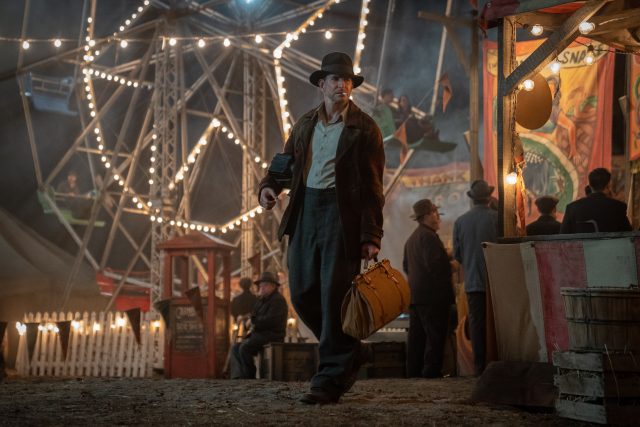Nightmare Alley: Sad but True, by David Bax

Guillermo del Toro’s Nightmare Alley is, to be clear, not a remake of Edmund Goulding’s 1947 film but rather another adaptation of William Lindsay Gresham’s 1946 novel. The hallmarks of noir fiction–a dissatisfied man cast his scruples aside and attempts to climb the ladder of American success through underhanded means and then, ultimately, pays for it–are inherent in the material. And Nightmare Alley has been adapted into other media, as well; there’s a graphic novel and a musical in existence. Still, del Toro is making the second movie version of this story and the influence of Goulding and of the golden era of film noir in general cannot be discounted. This is not just literary but also cinematic noir and those signifiers–light and dark; sharp angles; a chase through a trainyard–are well-represented too.
But, del Toro being del Toro, he latches onto the gothic horror opportunities the story presents as well. The traveling carnival in which Stanton Carlisle (Bradley Cooper) finds employment and anonymity after possibly murdering his own father offers plenty of foreboding and grotesque material, from freaks to funhouses and more. And when violence is visited upon characters, as it inevitably must be, it is gruesome, bone-snapping and flesh-tearing.
It’s also all quite beautiful. Del Toro is a director–one of the few left working under major Hollywood studios–who knows how to make movies look and feel like movies, larger than life, beautiful and otherworldly but without being false, costumey or condescending. Nightmare Alley may not have a lot in common with Steven Spielberg’s West Side Story but they come from the same sense of cinematic magic. Janusz Kaminski’s paintings made of light compare nicely with Dan Laustsen’s paperback covers made of ichor and shadow.
That’s not the only way this Nightmare Alley pays homage to its novelistic roots. Gresham began each chapter with a different tarot card. Del Toro doesn’t literally enumerate the different sections of the story but he marks their passage with slow fading transitions that feel like losing consciousness. We’re descending deeper into the nightmare with each one.
Given how quickly Nightmare Alley establishes its baseline cynicism about humanity, one would think there wouldn’t be much deeper to go. But when Clem (Willem Dafoe) describes to Stanton his simple methodology of preying upon human weakness to get someone to agree to be a sideshow geek, that’s just the beginning of the film’s inhumanity. Even a potentially empathetic message like “People are desperate to tell you who they are” becomes a philosophy of ruthless opportunism. And, by setting the film on the eve of the Second World War, del Toro is reminding us that, when it comes to mankind’s ability to dehumanize itself, there may always be further depths to plumb.
With Nightmare Alley, del Toro seems to be asking us if evil is something a person becomes or if it’s an innate trait that some of us are just missing the protections against that were placed in others somehow as children. Judging by the bleakness of its pitch-perfect final scene, the film is not optimistic about the answer.




























